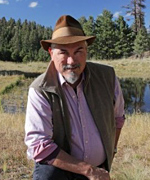On November 29, the Drought Contingency Plan (DCP) Steering Committee held what was billed as their final meeting. But of course, it wasn’t, or rather will not be. It just isn’t time yet.
Steering Committee meetings had been cancelled since October 25. Nothing was happening with DCP negotiations. Then unexpectedly, and on short notice, CAWCD held a special Board meeting on November 15. They had something, and they wanted to jump-start negotiations with it. CAWCD presented a proposal that satisfied agricultural interests, and involved several somewhat controversial features. One involved taking Intentionally Created Surplus (ICS) water off Lake Mead and using it to mitigate the impacts of DCP on Pinal County agriculture, though not to the full extent that irrigationists had wanted. CAP has parked almost 400,000 acre-feet of ICS on the lake since 2015 in order to slow the decline of water-level elevations and stave off a declared shortage (and it worked). But most people see this as little more than accounting smoke and mirrors, and fundamentally oppose taking water off the troubled lake. Most prominently, the cities (who paid for the ICS water) voiced dismay at the very concept, as did the tribal sector.
Two days before the special CAWCD Board meeting, Governor Ducey enunciated in an op-ed piece three major principles concerning the DCP negotiation process. First, no harm must come to Lake Mead, which would seem to let out the smoke and mirrors approach. Second, Arizona faces a drier future and must preserve long-term water resources. Third, mitigation of Colorado River shortages cannot last forever, because the shortages just might. And he called for compromise.
On November 29, people assembled to hear what most hoped was the final compromise proposal on DCP implementation that all three sectors could buy off on, thus paving the way for the Legislature to approve signatory authority for the ADWR Director to commit Arizona to the DCP with the other Colorado River Basin states, just in time.
The compromise presented at the November 29 Steering Committee meeting was based on the CAWCD proposal, but had been modified in a series of small meetings amongst major parties since November 15. It still had some CAP ICS coming off the lake and going to Pinal County, but incorporated offsets that would replace the CAP ICS, primarily with tribal ICS. This made taking ICS more palatable to several parties, including the Governor’s Office. Compensated system conservation would also play a role. The Colorado River Indian Tribes announced they would contribute 50,000 acre-feet of main stem water to the effort. The Gila River Indian Community announced they would contribute. Because the tribes will require compensation (about $68M), money is also a factor, and the ADWR Director announced that Governor Ducey had made a firm commitment to ask for $30M for this purpose in the next budget. CAWCD also offered up money. And the Walton Foundation stated they could contribute $8M. Progress had been made and, while details remained to be worked out, a successful implementation framework had emerged. And what did the sectors think of it?
Not a single representative of Pinal County agriculture voiced any support for the new and improved compromise proposal. Developers also complained that they received no mitigation water for CAGRD, and did not support the proposal. Most other delegates considered the compromise proposal as acceptable and professed support. Governor Ducey expressed his support on December 1 in another op-ed piece. It is clear, however, that several more meetings will be needed before the end of December to work through the objections of the agricultural and development interests. And these will apparently be public.
It’s all a matter of time. There is urgency in the need to get a compromise wrapped up and accepted so that the Legislature will provide signatory authority to ADWR. The negotiations between the seven Basin states on the next set of shortage guidelines (to replace the 2007 guidelines) begin in 2020 and must be concluded by 2026. If Arizona wants to be seen as a full partner, it must sign the DCP. So while DCP does not prevent shortage, it buys Arizona time: time to sign, time to save water, time to mitigate DCP impacts to agriculture, time to complete the next shortage guidelines negotiations before the situation is irretrievably lost. Tick, tock.
